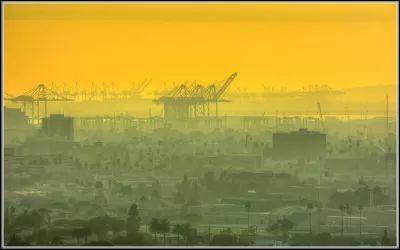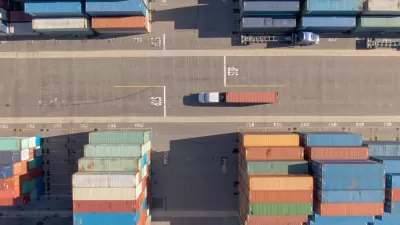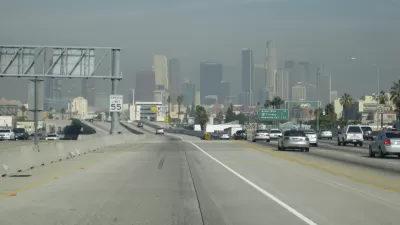Emissions from container ships idling outside Southern California's ports are adding to pollution that has blanketed the region in a noxious layer of smog.

Operations at the massive port complex that comprises the Port of Los Angeles and the Port of Long Beach, which have been experiencing delays as ships wait offshore to unload containers, are creating hazardous air quality for surrounding neighborhoods and the entire region, reports Alissa Walker.
These problems have existed since long before the current logjam brought the ports into national attention. "The neighborhoods around San Pedro Bay have become something of a sacrificial zone for U.S. commerce. The pollution from port operations is like having 6 million more cars driving around every day, and it’s estimated to cause 1,300 premature deaths in Los Angeles and Long Beach each year." As Walker notes, "Regulators noted an uptick in certain pollutants during a November with no measurable precipitation, reporting that emissions are up 75 percent compared to the same period in 2019, but they hesitate to declare a direct link between the smog and the port."
Yet when President Biden announced the ports would begin 24-hour operations to increase throughput, no public input was considered, according to an organizer with activist group East Yard Communities for Environmental Justice. "All the attention currently being showered on the supply chain is showing how quickly decisions can be made to favor what [environmental attorney Adriano] Martinez calls the freight-industrial complex at a cost to residents, who have been told to wait decades for basic reforms."
FULL STORY: L.A.’s Backed-up Port Is Smothering Neighborhoods in Smog

Study: Maui’s Plan to Convert Vacation Rentals to Long-Term Housing Could Cause Nearly $1 Billion Economic Loss
The plan would reduce visitor accommodation by 25,% resulting in 1,900 jobs lost.

North Texas Transit Leaders Tout Benefits of TOD for Growing Region
At a summit focused on transit-oriented development, policymakers discussed how North Texas’ expanded light rail system can serve as a tool for economic growth.

Why Should We Subsidize Public Transportation?
Many public transit agencies face financial stress due to rising costs, declining fare revenue, and declining subsidies. Transit advocates must provide a strong business case for increasing public transit funding.

How to Make US Trains Faster
Changes to boarding platforms and a switch to electric trains could improve U.S. passenger rail service without the added cost of high-speed rail.

Columbia’s Revitalized ‘Loop’ Is a Hub for Local Entrepreneurs
A focus on small businesses is helping a commercial corridor in Columbia, Missouri thrive.

Invasive Insect Threatens Minnesota’s Ash Forests
The Emerald Ash Borer is a rapidly spreading invasive pest threatening Minnesota’s ash trees, and homeowners are encouraged to plant diverse replacement species, avoid moving ash firewood, and monitor for signs of infestation.
Urban Design for Planners 1: Software Tools
This six-course series explores essential urban design concepts using open source software and equips planners with the tools they need to participate fully in the urban design process.
Planning for Universal Design
Learn the tools for implementing Universal Design in planning regulations.
City of Santa Clarita
Ascent Environmental
Institute for Housing and Urban Development Studies (IHS)
City of Grandview
Harvard GSD Executive Education
Toledo-Lucas County Plan Commissions
Salt Lake City
NYU Wagner Graduate School of Public Service




























